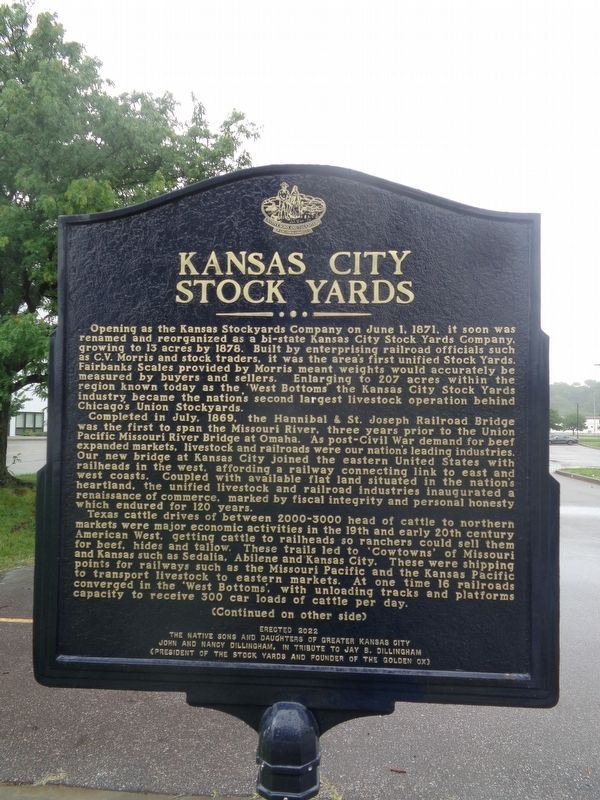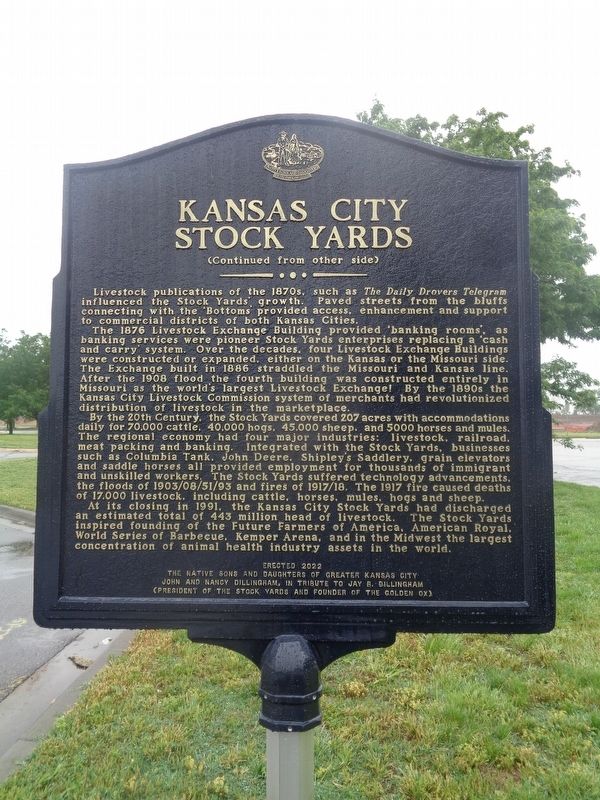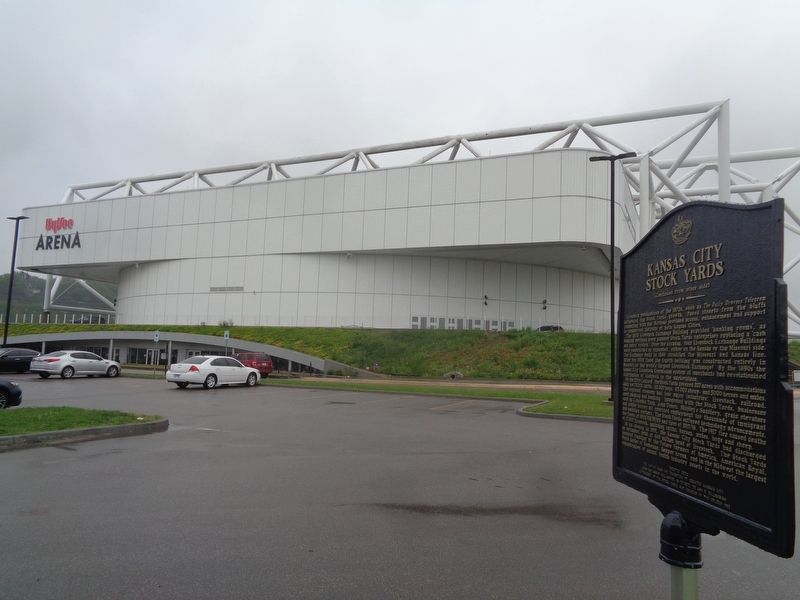Downtown Kansas City in Jackson County, Missouri — The American Midwest (Upper Plains)
Kansas City Stock Yards
Completed in July, 1869, the Hannibal & St. Joseph Railroad Bridge was the first to span the Missouri River, three years prior to the Union Pacific Missouri River Bridge at Omaha. As post-Civil War demand for beef expanded markets, livestock and railroads were our nation's leading industries. Our new bridge at Kansas City joined the eastern United States with railheads in the west, affording a railway connecting link to east and west coasts. Coupled with available flat land situated in the nation's heartland, the unified livestock and railroad industries inaugurated a renaissance of commerce, marked by fiscal integrity and personal honesty which endured for 120 years.
Texas cattle drives of between 2000-3000 head of cattle to northern markets were major economic activities in the 19th and early 20th century American West, getting cattle to railheads so ranchers could sell them for beef, hides and tallow. These trails led to 'Cowtowns' of Missouri and Kansas such as Sedalia, Abilene and Kansas City. These were shipping points for railways such as the Missouri Pacific and the Kansas Pacific to transport livestock to eastern markets. At one time 16 railroads converged in the 'West Bottoms', with unloading tracks and platforms capacity to receive 300 car loads of cattle per day.
Livestock publications of the 1870s, such as The Daily Drovers Telegram influenced the Stock Yards' growth. Paved streets from the bluffs connecting with the 'Bottoms' provided access, enhancement and support to commercial districts of both Kansas Cities.
The 1876 Livestock Exchange Building provided 'banking rooms', as banking services were pioneer Stock Yards enterprises replacing a 'cash and carry' system. Over the decades, four Livestock Exchange Buildings were constructed or expanded, either on the Kansas or the Missouri side. The Exchange built in 1886 straddled the Missouri and Kansas line. After the 1908 flood the fourth building was constructed entirely in Missouri as the world's largest Livestock Exchange! By the 1890s the Kansas City Livestock Commission system of merchants had revolutionized distribution of livestock in the marketplace.
By the 20th century, the Stock Yards covered 207 acres with accommodations daily for 70,000 cattle, 40,000 hogs, 45,000 sheep, and 5000 horses and mules, meat packing and banking. Integrated with the Stock Yards, businesses such as Columbia Tank, John Deere, Shipley's Saddlery, grain elevators and saddle horses all provided employment for thousands of immigrant and unskilled workers. The Stock Yards suffered technology advancements, the floods of 1903/08/51/93 and fires of 1917/18. The 1917 fire caused deaths of 17,000 livestock, including cattle, horses, mules, hogs and sheep.
At its closing in 1991, the Kansas City Stock Yards had discharged an estimated total of 443 million head of livestock. The Stock Yards inspired founding of the Future Farmers of America, American Royal, World Series of Barbecue, Kemper Arena, and in the Midwest the largest concentration of animal health industry assets in the world.
Erected 2022 by the Native Sons and Daughters of Greater Kansas City and John and Nancy Dillingham, in tribute to Jay B. Dillingham.
Topics and series. This historical marker is listed in these topic lists: Agriculture • Communications • Disasters
• Industry & Commerce. In addition, it is included in the Kansas City - Native Sons and Daughters of Greater Kansas City series list. A significant historical date for this entry is June 1, 1871.
Location. 39° 5.573′ N, 94° 36.385′ W. Marker is in Kansas City, Missouri, in Jackson County. It is in Downtown Kansas City. Marker is at the intersection of Arena Drive and American Royal Drive, on the right when traveling west on Arena Drive. Marker is located at the Hy-Vee Arena parking lot. Touch for map. Marker is at or near this postal address: 1800 Genessee St, Kansas City MO 64102, United States of America. Touch for directions.
Other nearby markers. At least 8 other markers are within one mile of this marker, measured as the crow flies. The French Bottoms - Early Day Kansas City (about 400 feet away, measured in a direct line); The American Royal (approx. 0.2 miles away); Andrew Drips Park (approx. 0.6 miles away); Kansas City (approx. 0.7 miles away); The Old French Cemetery (approx. one mile away); Lynching in America / Lynching of Levi Harrington (approx. one mile away); Chez Les Canses or "Chouteau's" (approx. one mile away); Chouteau’s Church (St. Francis Regis) (approx. one mile away). Touch for a list and map of all markers in Kansas City.
Also see . . . Kansas City Stockyards on Wikipedia. (Submitted on June 4, 2022, by Jason Voigt of Glen Carbon, Illinois.)
Credits. This page was last revised on February 10, 2023. It was originally submitted on June 4, 2022, by Jason Voigt of Glen Carbon, Illinois. This page has been viewed 922 times since then and 151 times this year. Photos: 1, 2, 3. submitted on June 4, 2022, by Jason Voigt of Glen Carbon, Illinois.


